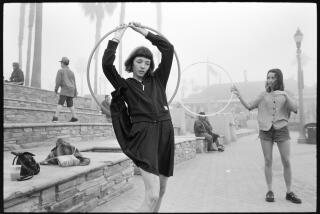‘The Photographer’ by Emmanuel Guibert, Didier Lefèvre and Frédéric Lemercier
- Share via
The Photographer
Into War-Torn Afghanistan With Doctors Without Borders
Emmanuel Guibert, Didier Lefèvre and Frédéric Lemercier
First Second: 268 pp., $29.95 paper
Whether the day’s news tells of air strikes, a new general or a surge in troops, the constantly shifting uncertainty of Afghanistan’s present has demanded our attention since 2001. A graphic novel offering an entry point into the country’s not-too-distant past is, then, unusual, illuminating and, in this case, breathtaking.
“The Photographer,” in Alexis Siegel’s vibrant translation from the French, takes us back to 1986, when photographer Didier Lefèvre accompanied a Médecins Sans Frontières (Doctors Without Borders) expedition into Afghanistan to establish one field hospital and staff another. The photographs taken by Lefèvre on that three-month trip form the heart of the book, which possesses a gritty, often gory reality. Lefèvre photographed villagers wounded by Soviet bombs; Afghan leaders who greeted, hosted and celebrated the members of the expedition; teenage mujahedin proudly displaying their machine guns before heading into battle; and the vast beauty and bombed-out destruction of the country.
It was a decade later when Lefèvre sat down with his friend and acclaimed French graphic novelist Emmanuel Guibert to tell his story. Guibert based his writing and drawing of the book on their hours of interviews, a working method that he also used to create the graphic novel “Alan’s War,” which was nominated for four Eisner awards -- the top honor in comics -- this year. Guibert tells Lefèvre’s story with engaging clarity, using his simple and expressive line drawings not to fill in holes around Lefèvre’s photographs, but to create a world in which the photographs come to life.
Within the book’s three-part structure, Guibert allows great freedom for digressions, reflections and what feel like spur-of-the-moment explorations. We pause, for instance, to hear a doctor’s story of how he came to Afghanistan; to listen to the mission’s leader, Juliette Fournot, discuss the role of women in the country; and to watch Lefèvre struggle, often comically, with Afghan customs. If this narrative looseness occasionally results in a lack of clarity, the story’s breadth and poignancy are always captivating.
For it is, finally, the journey of the 29-year-old photographer that elevates “The Photographer” beyond the status of a historical document, giving it the fullness and life of literature.
Early in the book, Lefèvre tells a doctor that technical perfection is one thing, but that to take a really good picture, “you have to search for it, search all the time, all the time.” We watch him take photographs when he’s half-asleep, under physical duress, even, finally, when he believes he is dying. This portrait of the artist is rendered even more moving by Lefèvre’s premature death in 2007.
“The Photographer’s” unique mix of talent and media allows the graphic novel form to flex its muscle to stunning effect. The book’s clear-eyed reflection on global politics, its touching portrait of a young man struggling to mature and its arresting visual narrative come together to create a story greater than the sum of its parts -- a story that is, ultimately, a sweeping declaration of human strength, compassion and creative power.
Watson is the author of “Vidalia in Paris.”
More to Read
The biggest entertainment stories
Get our big stories about Hollywood, film, television, music, arts, culture and more right in your inbox as soon as they publish.
You may occasionally receive promotional content from the Los Angeles Times.










